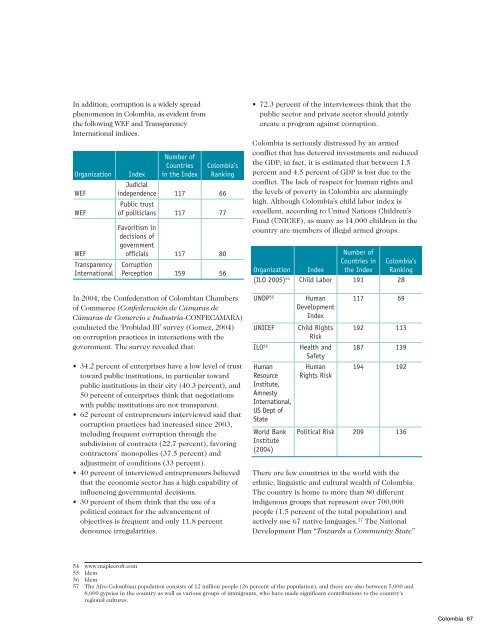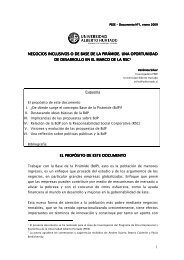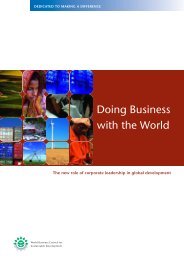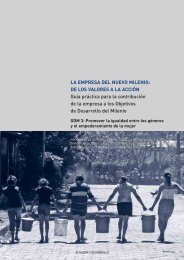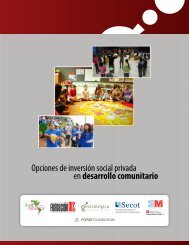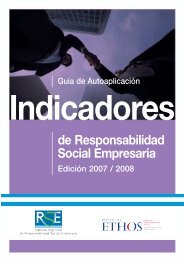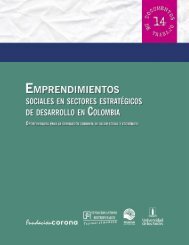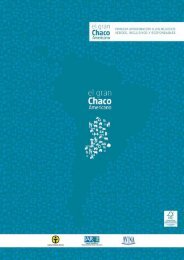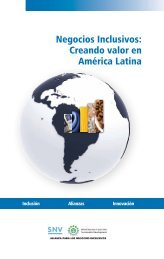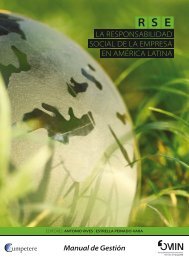Recommended actions to foster the adoption of Corporate Social ...
Recommended actions to foster the adoption of Corporate Social ...
Recommended actions to foster the adoption of Corporate Social ...
You also want an ePaper? Increase the reach of your titles
YUMPU automatically turns print PDFs into web optimized ePapers that Google loves.
In addition, corruption is a widely spreadphenomenon in Colombia, as evident from<strong>the</strong> following WEF and TransparencyInternational indices.OrganizationWEFWEFWEFTransparencyInternationalIndexNumber <strong>of</strong>Countriesin <strong>the</strong> IndexColombia’sRankingJudicialindependence 117 66Public trus<strong>to</strong>f politicians 117 77Favoritism indecisions <strong>of</strong>governmen<strong>to</strong>fficials 117 80CorruptionPerception 159 56In 2004, <strong>the</strong> Confederation <strong>of</strong> Colombian Chambers<strong>of</strong> Commerce (Confederación de Cámaras deCámaras de Comercio e Industria-CONFECAMARA)conducted <strong>the</strong> ‘Probidad III’ survey (Gomez, 2004)on corruption practices in inter<strong>actions</strong> with <strong>the</strong>government. The survey revealed that:• 34.2 percent <strong>of</strong> enterprises have a low level <strong>of</strong> trust<strong>to</strong>ward public institutions, in particular <strong>to</strong>wardpublic institutions in <strong>the</strong>ir city (40.3 percent), and50 percent <strong>of</strong> enterprises think that negotiationswith public institutions are not transparent.• 62 percent <strong>of</strong> entrepreneurs interviewed said thatcorruption practices had increased since 2003,including frequent corruption through <strong>the</strong>subdivision <strong>of</strong> contracts (22.7 percent), favoringcontrac<strong>to</strong>rs’ monopolies (37.5 percent) andadjustment <strong>of</strong> conditions (33 percent).• 40 percent <strong>of</strong> interviewed entrepreneurs believedthat <strong>the</strong> economic sec<strong>to</strong>r has a high capability <strong>of</strong>influencing governmental decisions.• 30 percent <strong>of</strong> <strong>the</strong>m think that <strong>the</strong> use <strong>of</strong> apolitical contact for <strong>the</strong> advancement <strong>of</strong>objectives is frequent and only 11.8 percentdenounce irregularities.• 72.3 percent <strong>of</strong> <strong>the</strong> interviewees think that <strong>the</strong>public sec<strong>to</strong>r and private sec<strong>to</strong>r should jointlycreate a program against corruption.Colombia is seriously distressed by an armedconflict that has deterred investments and reduced<strong>the</strong> GDP; in fact, it is estimated that between 1.5percent and 4.5 percent <strong>of</strong> GDP is lost due <strong>to</strong> <strong>the</strong>conflict. The lack <strong>of</strong> respect for human rights and<strong>the</strong> levels <strong>of</strong> poverty in Colombia are alarminglyhigh. Although Colombia’s child labor index isexcellent, according <strong>to</strong> United Nations Children’sFund (UNICEF), as many as 14,000 children in <strong>the</strong>country are members <strong>of</strong> illegal armed groups.Number <strong>of</strong>Organization IndexCountries in<strong>the</strong> IndexColombia’sRanking(ILO 2005) 54 Child Labor 191 28UNDP 55UNICEFILO 56HumanResourceInstitute,AmnestyInternational,US Dept <strong>of</strong>StateWorld BankInstitute(2004)HumanDevelopmentIndexChild RightsRiskHealth andSafetyHumanRights Risk117 69192 113187 139194 192Political Risk 209 136There are few countries in <strong>the</strong> world with <strong>the</strong>ethnic, linguistic and cultural wealth <strong>of</strong> Colombia.The country is home <strong>to</strong> more than 80 differentindigenous groups that represent over 700,000people (1.5 percent <strong>of</strong> <strong>the</strong> <strong>to</strong>tal population) andactively use 67 native languages. 57 The NationalDevelopment Plan “Towards a Community State”54 www.maplecr<strong>of</strong>t.com55 Idem56 Idem57 The Afro-Colombian population consists <strong>of</strong> 12 million people (26 percent <strong>of</strong> <strong>the</strong> population), and <strong>the</strong>re are also between 5,000 and8,000 gypsies in <strong>the</strong> country as well as various groups <strong>of</strong> immigrants, who have made significant contributions <strong>to</strong> <strong>the</strong> country'sregional cultures.Colombia67


